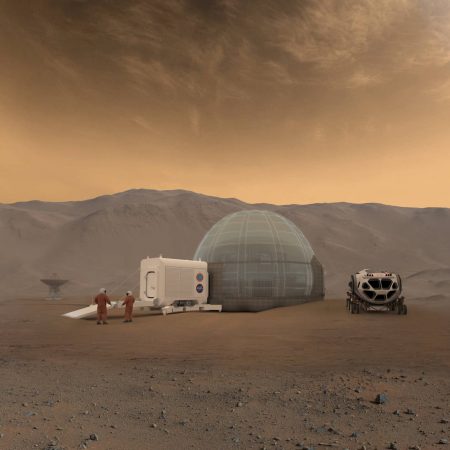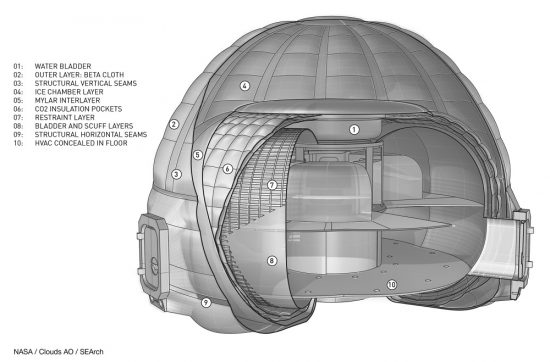January 3, 2017 – Not quite the ice block igloos built by Inuit in the extreme north here on Earth, NASA is contemplating something it calls a Mars Ice Dome as a suitable home for humans who visit the Red Planet. Like igloos it uses water ice as its main building material. But since water ice can only exist on the Martian surface for a very short period of time, the ice needs to be inside a protective material.
That’s why researchers at Langley Research Center have come up with an inflatable design that is easily transportable, and can be filled with water extracted from the planet’s subsurface where ice is abundant. Robots would do the job of inflating these Mars Ice Domes with water and carbon dioxide (CO2) before the arrival of human crews.
The water and CO2 would serve multiple purposes.
- The water would be an effective barrier to cosmic radiation which on the Martian surface represents a high cancer risk to humans visiting there.
- The water will allow light to pass through it making the environment far more accommodating to humans than an under ground habitat.
- The natural light will maintain human biorhythms and mental wellness.
- The CO2 will provide a thermal layer of insulation for heat retention.
- The structure’s interior would be multi-floored allowing for indoor maintenance of equipment and minimizing the need to do work outside in pressure suits, exposed to the elements.
- The water contained in the structure would serve as a storage tank that could be harvested for consumption and fuel creation for return voyages home.
A schematic of the Ice Dome shows the multi-layered structure and multi-tiered habitat. The launch mass form factor will be small but when inflated with water and CO2 will be of sufficient size and mass to accommodate a good-sized crew while withstanding the worst that Mars can throw at them.
So just how much water can be extracted from the Martian subsurface?
Based on current observations from rovers and orbiters it is estimated that a small water extraction device could harvest up to one cubic meter (35.3 cubic feet) per day, enough to complete the Ice Dome in 400 days. That rate could be accelerated using multiple systems or larger versions of the device.
The CO2, readily abundant in Mars’ atmosphere is an ideal solution for a thermal layer separating the ice from the living quarters beneath. Extracting it directly from the atmosphere should present too much difficulty.
The material used for the exterior layers of the habitat will be translucent. It will be capable of withstanding Martian dust storms, the corrosive perchlorates believed to be abundant in Martian water sources, the degrading potential of ultraviolet and charged-particle radiation that will bombard it continuously, and the presence of atomic oxygen which does degrade thermoplastics and polymer films.

Kevin Kempton, one of the members of the Langley team sees the Ice Dome as an ideal solution to living on the Martian surface. This will be a very hospitable place to live “after months of travel in space….a new home….ready for you to move in.”








